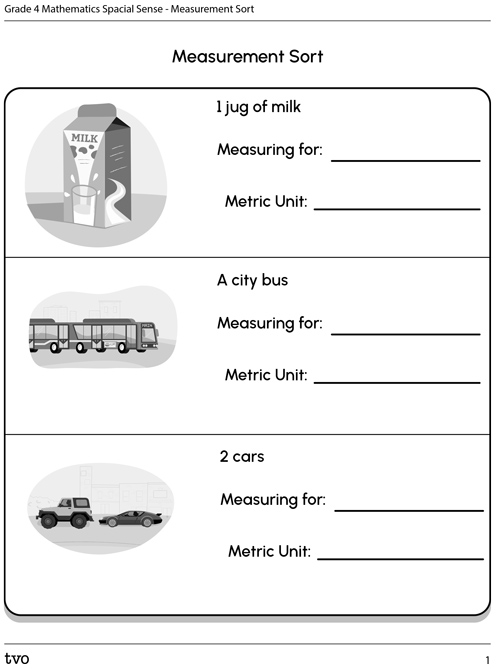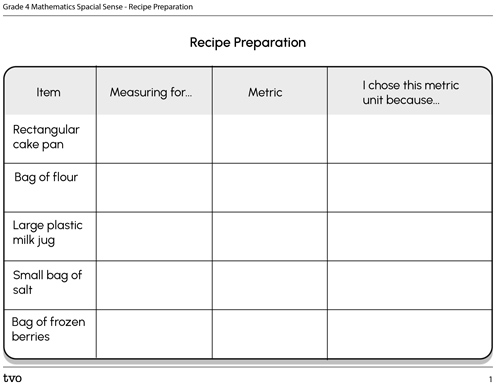Minds On
Measuring length
Explore this video entitled "Measuring Length" to learn more about measurement. In this video, Teacher Troy discusses measuring lengths and units of measurement.
- What kind of different metric units can we use to measure length?
- What kind of examples did the video provide for each measurement?
Record your ideas in a notebook or a method of your choice.
Action
Benchmarks for length
Let’s explore some of the benchmarks that we can use as a reference when we measure length.
The following images display benchmarks for 1 millimetre, 1 centimetre, 1 metre, and 1 kilometre.

There is a single ant that measures 1 millimetre. 10 ants lined up in a row would equal 1 centimetre. There is an image of a thumb. The width of the thumb is also 1 centimetre.

There is a single guitar that measures 1 metre. 1,000 guitars in a row would equal 1 kilometre. There is an image of part of a road. This part of a road also represents 1 kilometre.
Brainstorm
Benchmark brainstorm
Consider any other examples you might have of items which represent the metric units:
- 1 millimetre
- 1 centimetre
- 1 metre
- 1 kilometre
Record your ideas in a notebook or a method of your choice.
Now that we have our benchmarks for length, let’s review our benchmarks for mass and capacity.
Brainstorm
Benchmark brainstorm
Consider any other examples you might have of items which represent the following metric units:
- 1 gram
- 1 kilogram
- 1 millilitre
- 1 litre
Record your ideas in a notebook or a method of your choice.
Which metric unit?
When we measure mass, capacity, and length we try to use the metric unit which is the most accurate representation of the item.
For example, if we are measuring a bag of apples, we have a choice to measure in grams or kilograms.

If it is 1 apple, we might measure in grams.
- 1 apple = 100 grams
However, if it is 12 apples, the mass is much larger:
- 12 apples = 1,200 grams
To use numbers that are easier to communicate, we can change our metric unit to kilograms. Since 1 kilogram is equal to 1,000 grams, we would have:
- 12 apples = 1.2 kilograms
Measurement sort
Complete the following chart. For each item, consider whether to measure for mass, capacity, or length, and choose the appropriate metric unit.
You can complete this activity using the following fillable and printable Measurement Sort document. You can also use another method of your choice.
If you need some help, press the ‘Hint’ button for a helpful reminder about metric units.
Metric units for mass: grams and kilograms
Metric units for capacity: litres and millilitres
Metric units for length: millimetres, centimetres, metres, kilometresWhen you’re ready, press the ‘Answers’ button to reveal some possible answers for the Measurement Sort activity.
|
1 jug of milk 
Measuring for capacity Metric unit: litres A jug of milk contains liquid so I would measure capacity. It is bigger than a cup, so I would measure in litres. |
A city bus 
Measuring for mass Metric unit: kilograms A city bus is a large object, so I would measure in kilograms. |
2 cars 
Measuring for length Metric unit: metres A car is longer than a guitar, but shorter than a road. I would use metres to measure the cars back to back. |
|
3 oranges 
Measuring for mass Metric unit: grams I would use grams to measure 3 oranges because it is a small amount of fruit. If there were more, I might switch to using kilograms. |
A bed 
Measuring for length Metric unit: metres I would use metres to measure a bed, because I know that a guitar would fit across twice. |
A butterfly 
Measuring for mass Metric unit: grams I know that a butterfly is very light, so I would measure in grams. |
|
A staple 
Measuring for: length Metric unit: millimetre I would measure the staple for length and use millimetres since a staple is about the same size as an ant. |
5 paper clips 
Measuring for: mass Metric unit: gram A paper clip is used as a benchmark for grams, so I know that 5 paper clips would measure 5 grams. |
A bridge over a lake 
Measuring for length Metric unit: kilometre I would use kilometres to measure this bridge since it is longer than part of a road. |
Consolidation
Recipe preparation

Two students are working together to gather the ingredients they need to bake a cake.
They want to check that they have enough of each ingredient before they begin measuring for their recipe.
The following image displays their list of items:
DescriptionA pen with a list that has the following items: A rectangular cake pan, a bag of flour, a large plastic milk jug, a small bag of salt, a bag of frozen berries.
Using the list of items, determine:
- Is the item measured in mass, capacity, or length?
- Which is the most accurate metric unit to use?
Choose the appropriate metric unit for each item and explain your thinking.
You can record your thinking in the following fillable and printable Recipe Preparation document. You can also use another method of your choice to complete this activity.
Think about your learning
Respond to the following questions. You can record your thinking using a method of your choice.
- Why do we use different metric units to represent different objects or amounts?
- Have you noticed which metric units are most used to measure the objects in your surroundings?
- Find different objects in your surroundings that are labeled to show their mass or capacity. What do you find are the most common metric units?
Reflection
As you read through these descriptions, which sentence best describes how you are feeling about your understanding of this learning activity? Press the button that is beside this sentence.
I feel...
Now, record your ideas using a voice recorder, speech-to-text, or writing tool.
Connect with a TVO Mathify tutor
Think of TVO Mathify as your own personalized math coach, here to support your learning at home. Press ‘TVO Mathify’ to connect with an Ontario Certified Teacher math tutor of your choice. You will need a TVO Mathify login to access this resource.
TVO Mathify (Opens in a new tab)


